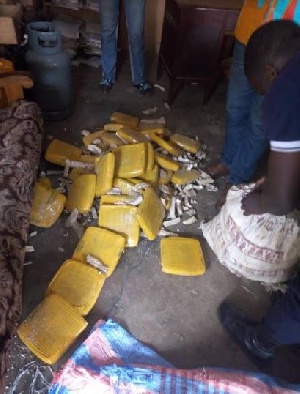 File photo: Police retrieve narcotic drugs after a bust
File photo: Police retrieve narcotic drugs after a bust
The Narcotics Control Board has revealed that it has stopped allowing the Police to keep seized cocaine in its custody as exhibits.
Though it is not clear why NACOB took this decision it is believed that the move was informed by previous instances where some quantities of the banned substance kept in police custody ‘turned’ into powdered cassava and baking soda.
“I can’t speak about the past issues with the Police Service. Now after effecting arrest we keep the seized cocaine (exhibits) by ourselves and arraign the suspects before the court, we no longer allow the Police to keep the banned substance,” Patrick Ofosu Agyapong a member of NACOB Education Department told sit-in-host Akwasi Nsiah on Anopa Kasapa on Kasapa FM.
In 2012, the four-member committee set up by then Chief Justice Georgina Woode to investigate the cocaine-turned-baking soda concluded in its final report that the swapping was done before the exhibit was tendered in court on September 27 2011.
The Justice Agnes Dodzie-led committee concluded that cocaine has a pungent smell but based on evidence before it the substance had no such smell.
The committee held that if there was any swapping, it was done before the substance was tendered in evidence at the court premises.
In 2006 a seized quantity of cocain in the custody of the CID turned into powdered cassava, known in local parlance as kokonte powder.
The controversy came to the fore after a defense counsel in a cocaine trial requested for retesting of the cocaine exhibit tendered in evidence.
He argued the exhibit was without the pungent smell known to accompany cocaine substance any time it is opened in any shape or form.
After retesting by the Ghana Standards Board it was revealed the substance was not cocaine but baking powder, leading to the acquittal of the suspect, Nana Ama Martin.
The police were quick to plead innocence, pointing accusing fingers at the court officials for presiding over the infamous swap.
The police then petitioned the Chief Justice to conduct an investigation into the matter and to expose how the cocaine turned into baking soda.